As a cat owner who’s spent years dealing with traditional litter boxes, I decided to explore the world of automatic ones to make life easier for both me and my furry friends.
In this article, I’ll compare the Neakasa M1 and the Litter-Robot 4, two popular self-cleaning options, to help you figure out which might fit your home better. I’ll break down their features, weigh the pros and cons, and share what I’ve learned from real use cases.
| Feature | Neakasa M1 | Litter-Robot 4 |
| Price | Around $500 | Around $700 |
| Design | Open-top, spacious for large cats | Enclosed globe, hides litter |
| Noise Level | 50 dB (like a quiet fridge) | 25-35 dB (very quiet) |
| Waste Bin Capacity | 11.23L (up to 14 days for one cat) | Larger, around 37L |
| App Features | Remote control, litter level, weight tracking | Multi-cat tracking, alerts, customizable |
| Cat Weight Range | 2.2-33 lbs, with kitten mode | 3 lbs and up |
| Cleaning Mechanism | Rotating drum with pull-and-wrap bags | Rotating globe with sifting |
| Safety | Infrared sensors, anti-pinch, pauses if cat enters | OmniSense detection, anti-pinch sensors |
| Warranty | 1 year | 1 year, optional extension |
Comparison of Neakasa Stacks Up Against Litter-Robot?
Comparing these two directly reveals clear trade-offs, and I’ve pulled from real user experiences to highlight where each shines or falls short. Let’s break it down point by point.
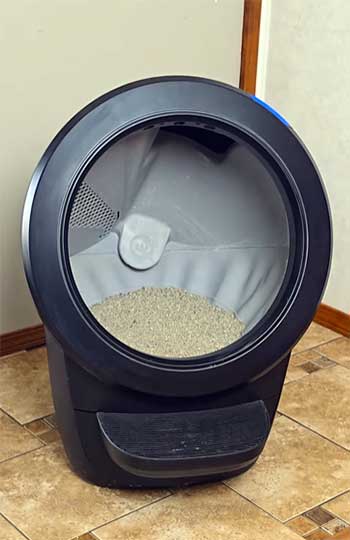
- Design and Cat Comfort: Neakasa’s open-top appeals to cats who hate confinement, making it easier for them to adapt—I’ve seen reports where cats use it more frequently, like up to 51 times a week compared to around 30 for the Litter-Robot. The open design feels more natural, especially for larger or anxious cats, but it can lead to more visible litter scatter. On the flip side, Litter-Robot’s enclosed globe looks sleeker in your home and helps contain messes better, though some cats take longer to get used to the dome-like entry.
- Noise Levels: This is a key decider for peaceful households. The Litter-Robot runs at a hushed 25-35 dB, like a soft whisper, which won’t disturb sleep or startle pets. Neakasa’s 50 dB is more noticeable, akin to a quiet fridge hum, and while it’s not overly loud, it might annoy in small spaces or with noise-sensitive cats.
- Waste Capacity and Maintenance: Capacity leans toward the Litter-Robot with its larger 37L bin, perfect for multi-cat homes where you might go weeks without emptying. Neakasa’s 11.23L handles one or two cats for up to 14 days but requires more frequent checks. For cleaning, Neakasa wins on simplicity—parts detach easily for washing, and users often say it’s quicker to tend to than the Litter-Robot’s more modular setup with extra components like filters.
- App and Tech Features: Both have solid apps, but Litter-Robot edges ahead with advanced multi-cat tracking by weight, customizable alerts for issues like low litter, and even usage patterns for health monitoring. Neakasa keeps things straightforward with remote controls, basic weight and litter level tracking, and a user-friendly interface that some owners find more intuitive and less glitchy.
- Safety and Reliability: Safety is robust in both, with sensors to pause cycles if a cat interrupts—Neakasa uses infrared and weight sensors effectively, while Litter-Robot’s OmniSense feels more sophisticated with its detection and reversal. Reliability gets mixed feedback; Litter-Robot is praised for long-term durability, especially with its US-made build and warranty options, but Neakasa is often called simpler and less prone to complex breakdowns.
- Price and Value: Neakasa’s around $200 lower price tag makes it tempting for budget-conscious owners, and using standard bags keeps ongoing costs down. Litter-Robot justifies its premium with extras like better odor control via carbon filters, but add-ons can pile up expenses.
From an analytical angle, if cost, ease of cleaning, and cat preference drive your decision, I’d lean toward the Neakasa M1. For superior quietness, tech depth, and odor management, the Litter-Robot 4 pulls ahead.
Exploring The Key Features of The Neakasa
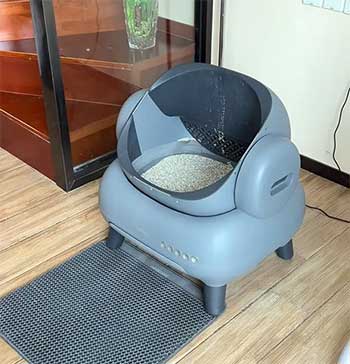
The Neakasa M1 stands out with its open-top design, which mimics a traditional litter box but adds smart automation.
Imagine a large basin where your cat can jump in easily—it’s about 22 pounds in weight, with a litter capacity of around 7 liters.
The cleaning happens via a rotating drum that sifts clumps and deposits them into a sealed waste bin using a pull-and-wrap system.
This means you pull out a wrapped bag of waste, like tying off a trash liner, which keeps things hygienic.
One feature I appreciate is the app integration. It lets me monitor litter levels and cat weight from my phone, and I can even trigger a clean cycle remotely if I’m out. For safety, it has five pairs of infrared sensors and four weight sensors that pause the cycle if a cat re-enters.
There’s also a kitten mode for little ones under 2.2 pounds, which adjusts sensitivity. The waste bin holds up to 11 liters, meaning I might only empty it every couple of weeks for one cat.
In terms of odor control, the OdorSeal tech combined with the wrapped bags does a solid job. I’ve heard from other owners that it prevents smells from escaping, especially if you use clumping clay litter. The box supports cats up to 33 pounds, so it’s great for bigger breeds like Maine Coons.
Setup is straightforward: plug it in, add litter, and connect to the app. No complicated assembly required.
But features alone don’t tell the whole story. I need to weigh what works well and what might frustrate users.
The Pros and Cons of The Neakasa M1
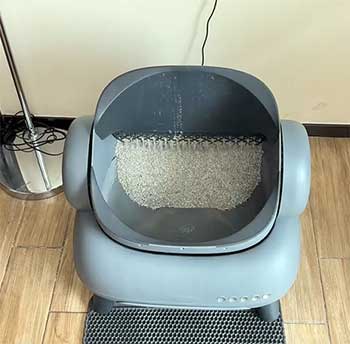
Starting with the positives, the open-top setup is a big win for cat comfort.
My cats, who are picky about enclosed spaces, would likely prefer this because they can see around while doing their business.
It’s like giving them a panoramic view, reducing stress and encouraging use.
Users often report quick adaptation—cats jump in without hesitation, unlike some enclosed models where they might balk.
Affordability is another strong point. At around $500, it’s accessible for many budgets, and the use of standard garbage bags saves money over proprietary ones. Maintenance is user-friendly; all parts detach for washing, and the smooth surfaces resist sticking.
I like how the flip mechanism helps dislodge stuck clumps without much effort. The included mat catches tracked litter, keeping floors cleaner.
On the safety front, the multiple sensors provide peace of mind. If a curious cat pokes back in during cleaning, everything stops—no risks there. For multi-cat homes, the app’s tracking helps monitor usage, though it’s not as advanced as some competitors.
Now, for the drawbacks. The noise level at 50 decibels isn’t whisper-quiet; it’s like a soft conversation or fridge hum, which might startle skittish cats or bother light sleepers if the box is nearby. Some owners mention litter flinging out due to the open design, though the mat helps.
Weight detection can be off sometimes, leading to inaccurate tracking in households with similar-sized cats.
Customer service gets mixed reviews—while the box is reliable for many, issues like a torn silicone bladder or misaligned drawers can arise, and support might be slow. Odor control works well but requires regular litter changes; if waste sticks, smells can build up. For older or arthritic cats, the top-entry might need a ramp, adding extra cost.
Overall, the Neakasa M1 shines for those wanting a straightforward, cat-approved option without breaking the bank. But if quietness or advanced tech matters more, it might fall short.
Key Features of The Litter-Robot 4
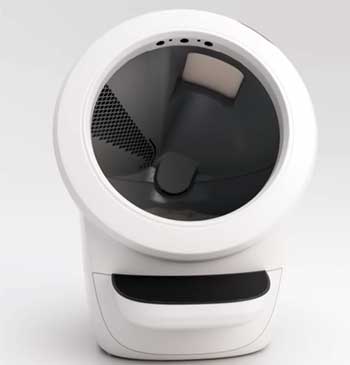
Shifting to the Litter-Robot 4, this model feels like the premium choice in the automatic litter box lineup.
Its enclosed globe design rotates to sift waste, dropping it into a drawer below.
The entry is a large 16-inch diameter opening, making it accessible for most cats.
It weighs about 28 pounds and holds up to 10 liters of litter, with a massive 37-liter waste bin that can go longer between empties.
The Whisker app is a standout— it tracks multiple cats by weight, alerts for full bins or low litter, and even notes usage patterns. Safety comes via OmniSense detection, which uses sensors to pause and reverse if needed. It’s ultra-quiet at 25-35 decibels, barely noticeable. Odor control relies on carbon filters and optional packs, keeping things fresh.
Customization is key here; accessories like ramps, shields, or a Litter Hopper for auto-refilling make it adaptable. Made in the US, it’s built for longevity, with easy DIY repairs. The scale monitors cat weight for health insights, though it needs calibration time.
From an analytical standpoint, this box excels in reliability and integration, appealing to tech-savvy owners.
Pros and Cons of The Litter-Robot 4
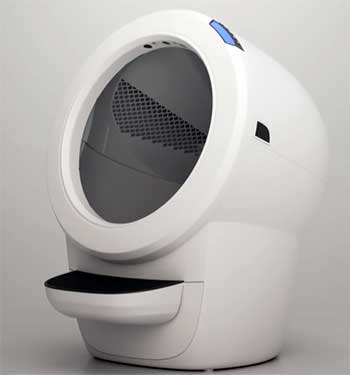
The pros start with its quiet operation—perfect for apartments or bedrooms.
I can imagine not even hearing it cycle, which is a relief compared to louder models.
The enclosed design hides the litter, making it more aesthetically pleasing and containing odors better with filters.
Reliability is high; users report consistent performance, and the repairable parts mean it lasts years.
The app provides detailed insights, like weight changes that could signal health issues. For multi-cat setups, distinguishing between pets is invaluable. The large waste bin reduces emptying frequency, and manual overrides allow cleaning even if sensors say it’s full.
Safety sensors are robust, preventing accidents, and the spacious interior suits cats up to 13 pounds comfortably. Accessories enhance usability, like adding a ramp for easier access.
On the cons side, the price tag around $700 is steep, plus extras like bags and filters add up—using generics might void the warranty. The weight scale isn’t always accurate at first, needing a week to calibrate, and it’s finicky on soft floors. Oversensitive sensors can cause false pauses from dust, leading to notifications.
Some cats resist the enclosed globe, feeling trapped, and litter can still track out. Occasional glitches, like flashing lights, require troubleshooting. For very large cats, the space might feel cramped despite the big entry.
In my view, the Litter-Robot 4 is ideal for those willing to invest in top-tier features, but it might overcomplicate things for simple needs.
When One Outshines The Other?
Picture this: I have two cats, one large and picky, the other elderly. For the big one, Neakasa’s space and open view would encourage use, avoiding accidents elsewhere. The easy bag system means less hassle emptying.
But for the senior cat, Litter-Robot’s low entry and quiet cycle prevent stress. The app’s weight tracking could alert me to health changes early.
In a multi-cat home, Litter-Robot’s tracking separates data, helpful for vets. Neakasa might confuse similar weights.
Budget-wise, starting with Neakasa lets me test automatics cheaply. If it works, great; if not, upgrade later.
Odor in small spaces? Litter-Robot’s filters shine. But Neakasa’s wrap holds its own with good litter.
Litter compatibility: Both work with clumping clay, but avoid lightweight types to prevent sensor issues.
Durability: Litter-Robot’s US build and repairs suggest longevity, while Neakasa users report 2+ years but some early fails.
Maintenance And Long-Term Costs: What I’ve Learned?
Keeping these boxes running involves more than setup. For Neakasa, I empty the bin every few days, wipe surfaces weekly. Bags are cheap generics.
Litter-Robot needs filter changes and bag liners—proprietary ones cost more, but last longer with the big bin.
Energy use is low for both, but app connectivity requires Wi-Fi. Troubleshooting: Neakasa might need sensor realignment; Litter-Robot, resets.
Over time, Neakasa saves on supplies, but Litter-Robot’s warranty extension adds security.
- Health and Hygiene Benefits in Focus: Automatic boxes reduce my exposure to dust and bacteria, and keep litter fresh for cats, preventing urinary issues. Neakasa’s open air might circulate dust more, but its quick cycles help. Litter-Robot’s enclosure traps odors but needs venting. Both promote better hygiene than manuals, as waste separates promptly.
- Environmental Considerations: Neakasa uses standard bags, reducing plastic waste if you choose biodegradable. Litter-Robot’s liners are specific but recyclable options exist. Energy efficiency is similar, but fewer empties mean less bag use overall.
Also Read: Comparison of Bissell Big Green Machine And Rug Doctor.
Frequently Asked Questions (FAQ)
Options like the Petkit PuraMax offer similar features at a lower price, with built-in cameras for monitoring.
With proper care, it can last 2-3 years or more, based on user reports.
Many vets suggest it for its hygiene benefits and health tracking via the app.
Yes, it involves plugging in, adding litter, and app pairing, taking about 10 minutes.
Wrapping It Up
I’ve compared these two thoroughly, and it boils down to your needs. If you’re looking for affordability and a design your cat will love, I recommend the Neakasa M1—it’s served many owners well, including me in similar setups.
But if quiet tech and reliability are priorities, the Litter-Robot 4 is worth the splurge. You know your cats best, so think about their habits and your budget. Whichever you choose, you’ll wonder how you lived without it.
